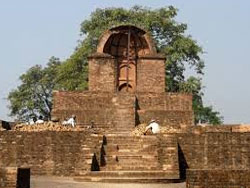
श्रावस्ती या श्रावस्ती बुद्ध के जीवन से अच्छी तरह से जुड़े हुए हैं। पूर्वोत्तर उत्तर प्रदेश में राप्ती नदी के पास स्थित शहर कहा जाता है कि पौराणिक राजा स्रावासह द्वारा स्थापित किया गया था। बौद्ध काल (6 वीं शताब्दी ईसा पूर्व -6 वीं शताब्दी ईस्वी) में, श्रावस्ती कोसाला राज्य की राजधानी थी और दोनों एक समृद्ध व्यापार केंद्र और उसके धार्मिक संगठनों के लिए महत्वपूर्ण थे। माना जाता है कि बुद्ध को 24 मानसून शहर में बिताए हैं। यह कहा जाता है कि बुद्ध एक हजार पंखुड़ियों के साथ कमल पर बैठे थे और उनकी छवि को एक लाख बार गुणा किया था। एक दिव्य दृष्टि जो अपने समीक्षकों को चुप कर रही थी शात-महेत के गांव के पास उम्र-पुरानी स्तूप, राजसी मठ और कई मंदिर, श्रावस्ती के साथ बुद्ध के सहयोग को उजागर करते हैं। एक महत्वपूर्ण धार्मिक स्थल जेटवन मठ है, जो शहर की दीवारों के बाहर एक बगीचे में खड़ा हुआ था और एक अमीर बैंकर, अनंतपिनका द्वारा बुद्ध को प्रस्तुत किया था। अन्य महत्वपूर्ण बौद्ध मठ राजकारम और पूरराम थे। यहां एक उत्कृष्ट उद्यान में प्रसिद्ध 'आनंदोत्सव' का पेड़ है - एक का वंश जिसे बुद्ध के मुख्य शिष्य आनंद ने लगाया था। माना जाता है कि 'सोबनाथ' मंदिर जैन तीर्थंकर का जन्मस्थान 'संभवनाथ' माना जाता है, जिससे श्रावस्ती जैनों के लिए एक महत्वपूर्ण केंद्र बना है। शहर में बलमंपुर के उत्तर-पश्चिम में साहेथ और महथ के जुड़वां गांवों की पहचान की गई है। आज यह पृथ्वी और ईंट के एक महान दल द्वारा घिरा हुआ है। खुदाई भारत के पुरातत्व सर्वेक्षण द्वारा किया गया है।
कैसे पहुंचा जाये
वायु: निकटतम हवाई अड्डा लखनऊ, 151 किमी दूर है।
रेलवे: बलरामपुर रेलवे स्टेशन, 1 9 किमी दूर|
सड़क: सरस्वती तक पहुंचने का सबसे सुविधाजनक तरीका लखनऊ के माध्यम से है|
यात्रा की जगहें
शोभनाथ मंदिर
'शोभनाथ' मंदिर को जैन तीर्थंकर 'संभवनाथ' का जन्म स्थान माना जाता है, जिससे श्रावस्ती जैनों के लिए एक महत्वपूर्ण केंद्र बनाते हैं।
महथ
शहर के अवशेषों के साथ की पहचान, महथ में लगभग 400 एकड़ क्षेत्र का क्षेत्र शामिल है। खुदाई ने शहर के बड़े दरवाजे, भगदड़ और अन्य संरचनाओं के खंडहर का पर्दाफाश किया है, जो प्राचीन श्रर्वति की समृद्धि की गवाही देते हैं। सोबनाथ मंदिर यहां स्थित है। पक्की कुटी और कांची कुटी शायद बौद्ध मंदिर थे, इससे पहले कि वे ब्राह्मण मंदिरों में परिवर्तित हो गए थे।
साहेथ
मुख्य रूप से जेटवन मठ की साइट के रूप में जाना जाता है, साहेथ 32 एकड़ क्षेत्र का क्षेत्र शामिल करता है। महथ के दक्षिण-पश्चिम में एक चौथाई मील की दूरी पर स्थित यह तीर्थ यात्रा का एक महत्वपूर्ण स्थान बन गया, जिसमें कई मंदिर, स्तूप और मठ थे। स्तूप अधिकतर कुशाण काल में होते हैं, जबकि मंदिर गुप्ता शैली में होते हैं।
Shravasti or Sravasti is intimately associated with the life of Buddha. The town located near the Rapti River in northeastern Uttar Pradesh is said to be have been founded by the mythological king Sravast. In Buddhist times (6th century BC-6th century AD), Shravasti was capital of the kingdom of Kosala and was important both as a prosperous trading centre and for its religious associations. Buddha is believed to have spent 24 monsoons in the city. It is said that Buddha sat on a lotus with a thousand petals and multiplied his image a million times. A divine sight that silenced his critics. Age-old stupas, majestic monasteries and several temples near the village of Sahet-Mahet, highlight Buddha's association with Shravasti. An important religious site is the Jetavana Monastery, which was erected in a garden outside the walls of the city and presented to the Buddha by a wealthy banker, Anathapinaka. Other important Buddhist monasteries were the Rajakarama and the Purvarama. An exquisite garden here has the famous 'Anandabodhi' tree - an offspring of one said to be planted by Buddha's main disciple Ananda. The `Sobhanath' temple is believed to be the birth place of Jain tirthankar 'Sambhavanath' making Shravasti an important centre for the Jainas. The city has been identified with the twin villages of Saheth and Maheth northwest of Balrampur. Today it is surrounded by a great rampart of earth and brick. Excavation has been undertaken by the Archaeological Survey of India.
How to Reach
Air : Nearest airport is Lucknow, 151 km away.
Railway : Balrampur railway station, 19 km away.
Road : The most convenient way to reach Sravasti is via Lucknow
Sights to Visit
Shobhanath Temple
The `Shobhanath' temple is believed to be the birth place of Jain tirthankar 'Sambhavanath', making Shravasti an important centre for the Jains.
Maheth
Identified with the remains of the city, Maheth covers an area of about 400 acres. Excavations have exposed the massive gates of the city, ramparts and also the ruins of other structures, which stand testimony to the prosperity of ancient Sravasti. The Sobhanath Temple is located here. Pakki Kuti and Kacchi Kuti were probably Buddhist shrines, before they were converted into Brahmanical temples.
Saheth
Known primarily as the site of the Jetavana monastery, Saheth covers an area of 32 acres. Lying about a quarter of a mile to the south - west of Maheth, it became an important place of pilgrimage, adorned with numerous shrines, stupas and monasteries. The stupas belong mostly to the Kushana period, while the temples are in the Gupta style.